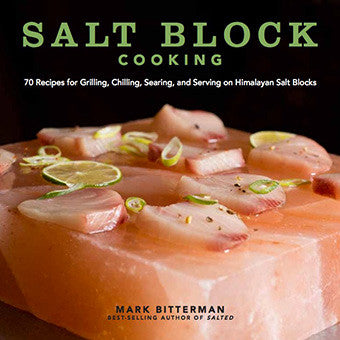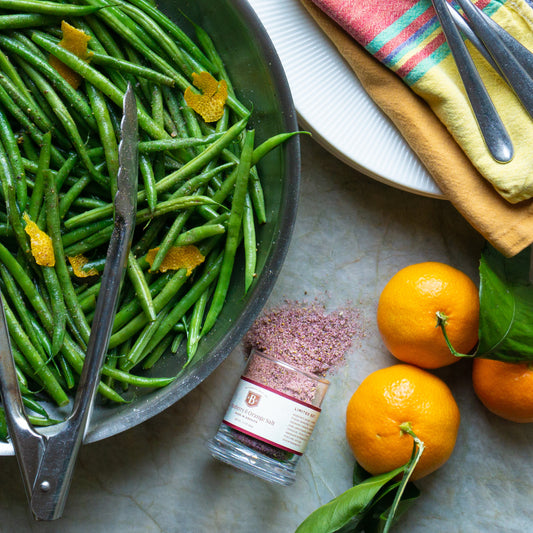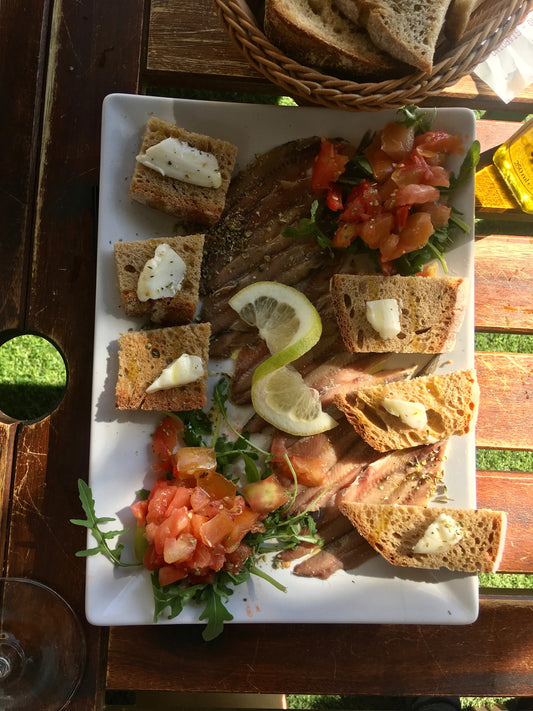
A boulder emerges...
A boulder of Himalayan rock salt emerges from darkness of a 16th century mineshaft in Pakistan and explodes into light, catching and refracting the sun in hues ranging springwater clear to hibiscus pink to venison red. Stonemasons in a neighboring town then hand cut the great rock into a variety of shapes, providing the foundation for extraordinary new ways to prepare and serve food. The Meadow's Himalayan salt blocks, plates, bricks, and platters can be used for sautéing, grilling, chilling, curing, baking, presenting, salting, bathing, building, and contemplating. There are as many uses for The Meadow's heavy slabs of Himalayan Pink Salt blocks as there are foods, cooking styles, whims, acts of folly, and shows of bravado. Serve moist food on it, such as mozzarella and sliced apples, and the food will pick up a delicate saltiness that sets it off perfectly. Heat a salt block on the stove, then set the hot block on a trivet at the table to sear scallops or thinly sliced hanger steak while seated with your guests.
Cooking on a Salt Block
The crystal lattice of our Himalayan Pink Salt Blocks has a high specific energy (energy per unit of mass), so they hold any temperature you bring it to for a good while. Likewise, this makes for excellent heat distribution, making grandma's heavy old cast iron skillet seem like tinfoil by comparison.
Because Himalayan Salt Blocks generally have an extremely low amount of porosity, and virtually no residual moisture (.026%), the salt plates can be safely heated or chilled to great extremes. We have tested them from 0°F up to 700°F (-18°C to 370°C). Salt melts at 1473.4°F (800.8°C).
Two other considerations come into play when working with our Himalayan salt blocks. First, their lack of porosity means that the surface area touching your food is minimal, so these large blocks of salt will impart only a very moderate saltiness. Second, the high quantity of trace minerals (1.2% sulfur, .4% calcium, .35% potassium, .16% magnesium, and 80 other trace minerals) impart a more mild and full taste to the salt, and by extension, more flavor complexity to your food.
Heating a Salt Block
Be sure the block is completely dry. If used previously, the block should have rested for at least 24 hours. Himalayan salt blocks like to be pampered, especially at first. So, as a rule, be especially careful the first few times you heat up your salt plate. The first few times you heat up your salt block, fissures and cracks will appear, and the color may change from its original pink to a whiter color. This is normal. However, after successive uses, you may find that the salt block regains some of its original hue, largely as a result of washing.
For a Gas Range: Put the your salt block on the stove top. Set heat to low, give the block at least 15 minutes to heat up. You may notice moisture accumulating at the edges. As the salt block heats, this will evaporate off. The slower you do this, the better. Allow more time for larger plates, especially 9x9x2 inches and larger. Increase the heat slowly – low-medium for 15 minutes, and then medium-high for 15 minutes. If extremely hot sauté temperatures are desired, increase flame to full high for another 5 to 10 minutes.
How do you know when your block is ready to use? If you have a laser thermometer, the block should be at least 500 degrees F. If you don’t, simply sprinkle a few drops of water on the block. If they sizzle away instantly, the block should be hot enough.
For an Electric Range: If heating on the stovetop, select a circular ring of metal, such as a tart pan with a pop out bottom, pastry ring, or wok ring, and place it on the burner. Place the salt block on top of the ring. Place a circular ring of metal such as a tart pan with a pop-out bottom to create a small air gap between the heating element and the block. Once set up, heat similarly to a gas range.
For a Grill: Place your salt block on the grate. If using a charcoal grill, keep the coals to one side and place the block on the other side, to expose it to less direct heat. If using a gas grill, start the heat on low as you would with a gas range. Increase heat slowly until the block is ready to use, as described in the gas range instructions.
For an Oven: We do not recommend using an oven to heat your salt block, as damage to your salt block and/or your oven may result. If you would like to bake on your salt plate, heat it as described above to at least three hundred degrees, and then move it into a hot oven.
Cooking on a Salt Block
Every type of food will react uniquely to your salt block. The effect of the salt on the food will depend on a variety of factors - moisture, fat content, thickness, and the temperature of the block. Moisture in the food will pick up salt faster, while fat will repel the salt. If your food is too salty, apply a thin layer of oil to the block.
Foods that cook quickly usually work best, so make sure pieces are cut to an appropriate thickness and that the block is hot enough. Cooking on a salt block that hasn’t been heated high enough will not only over-salt your food, but it will also degrade your block much faster.
Salt blocks turn opaque when heated, and may develop fissures or even large cracks. They may also take on color from the proteins cooked on it. Don’t get upset by the behavior of your salt block. Salt is a complicated, wily, unpredictable substance. That is what gives it much of its charm.
Keep the block’s ‘top’ and ‘bottom’ the same each use so that you sear food on the same side for the life of the block. When you flip it, fissures that have formed can become more pronounced.
Caring for a Salt Block
Cleaning: If hot, allow your block to cool completely first. Moisten the salt block with a damp sponge (do not use soap). Scrub with a soft brush or green scouring pad to remove any stuck matter, and wipe clean with the sponge. Try to keep the block as dry as possible – the less water the better. Repeat until the block is free of any cooked on food. Tamp dry with a paper towel or clean cloth, and set on a drying rack. This process removes only a very thin layer of the salt and preserves a relatively smooth surface.
Treated with care, a large salt block can provide dozens of uses. The powerful antimicrobial properties of the salt insure that it is always proper and ready for future use, with no need for detergents.
Storing: Store in any location where humidity is at a minimum. I keep many of mine on the windowsill. If you live in a humid climate, wrap the block in a towel and put in the cupboard.
Disclaimer
If you wish to cook on your salt block, please understand that you assume all responsibility. The Meadow or its staff is not responsible for damages, injury, or loss due to the use of our Himalayan Salt products. This includes any that may result from the heating of Himalayan Salt blocks or similar products.



















